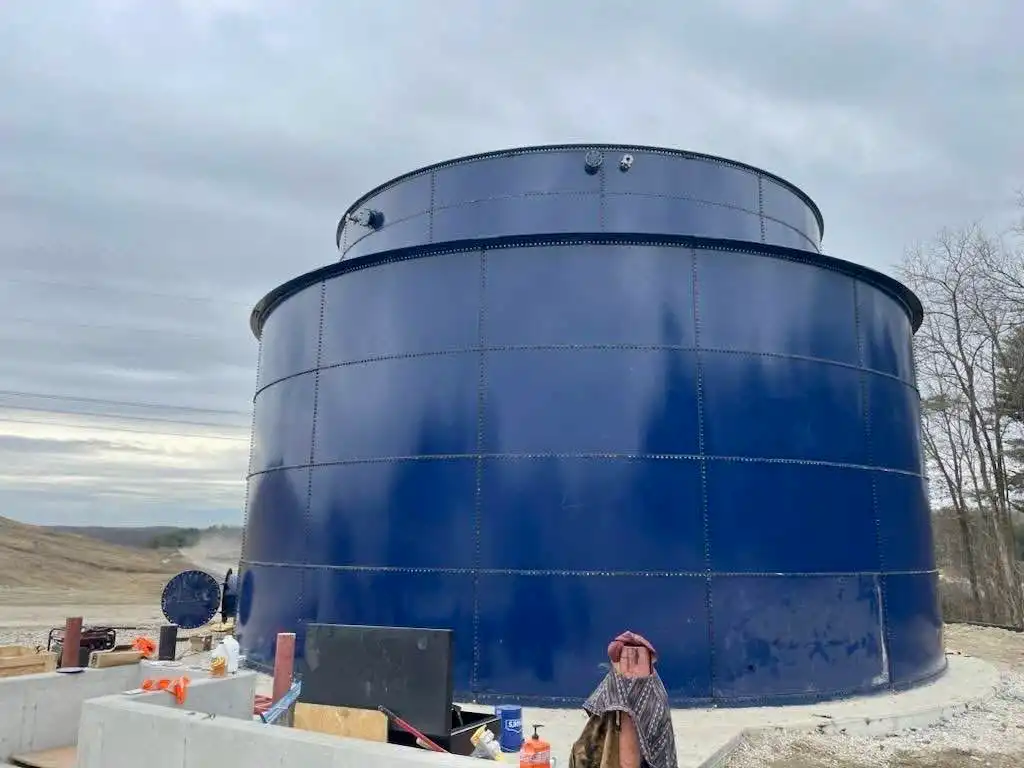Unlocking the Science Behind Leachate Tanks: A Comprehensive Guide
If you’ve ever wondered what goes on below the surface when it comes to managing landfill waste, then this comprehensive guide to leachate tanks will provide you with all the answers you need. Unleash your curiosity as we delve into the fascinating world of leachate management and discover the science behind it.
Leachate tanks play a vital role in environmental protection and waste management practices. Understanding how they work and their purpose is crucial to ensure effective pollution control and prevent any harm to ecosystems.
In this guide, we’ll take you through the entire lifecycle of leachate tanks step by step. From their construction and design considerations to the sophisticated technologies used for leachate collection and treatment, we leave no stone unturned. Learn about the different types of leachate tanks, their maintenance requirements, and how they impact human health, including advancements like Weston PowderCoat™ (WPC) and Weston NanoCoat™ (WNC) which provide durable and sustainable solutions in tank construction and maintenance.
Whether you’re an industry professional, a researcher, or someone with a general interest in environmental conservation, this comprehensive guide will equip you with the knowledge needed to understand and appreciate the science behind leachate tanks. Get ready to unlock the secrets that lie beneath the surface and take a deep dive into the world of leachate management.
Understanding Leachate and its Composition
Leachate is a liquid that is formed when water percolates through waste materials, such as those found in landfills or waste storage facilities. It is a complex mixture of various organic and inorganic substances, including dissolved and suspended solids, heavy metals, pathogens, and various chemicals. The composition of leachate can vary depending on the type of waste being stored and the age of the landfill.
The presence of leachate poses significant environmental risks if not managed properly. It can contaminate groundwater and surface water bodies, leading to the pollution of drinking water sources and the degradation of aquatic ecosystems. Therefore, it is crucial to implement effective leachate management systems to prevent these potential hazards.
The Importance of Leachate Management
Leachate management is essential for the protection of the environment and public health. By effectively managing leachate, we can minimize the potential risks associated with landfill operations and ensure the long-term sustainability of waste management practices.
One of the primary goals of leachate management is to prevent the release of contaminants into the environment. Leachate tanks play a crucial role in achieving this goal by providing a containment system for the collection and treatment of leachate. These tanks are designed to prevent leachate from seeping into the surrounding soil and groundwater, thereby minimizing the potential for contamination. Incorporating materials like Weston PowderCoat™ (WPC) and Weston NanoCoat™ (WNC) in the construction of these tanks enhances their durability and chemical resistance, ensuring the safe containment of leachate over time.
Proper management of leachate also helps to control odors and reduce the attraction of pests and vectors, such as rats and flies. By containing and treating leachate, we can minimize the negative impacts on air quality and public health in the vicinity of landfill sites.
Types of Leachate Tanks and Their Functionalities
Leachate tanks come in various shapes and sizes, depending on the specific requirements of the landfill site. The two main types of leachate tanks commonly used are open tanks and closed tanks.
Open tanks, also known as lagoons or ponds, are typically large, shallow structures that allow leachate to evaporate or infiltrate into the soil. These tanks are suitable for sites with low leachate volumes and where evaporation and infiltration are feasible options for leachate disposal.
Closed tanks, on the other hand, are designed to completely contain and store leachate. They are typically constructed using impermeable materials, such as concrete or high-density polyethylene (HDPE), to prevent any leakage or seepage of leachate. Closed tanks are preferred for sites with high leachate volumes or where evaporation and infiltration are not viable options. The addition of Weston PowderCoat™ (WPC) and Weston NanoCoat™ (WNC) to the repertoire of construction materials offers enhanced protection against leaks and environmental impact, further securing the containment of leachate.
In addition to storage tanks, leachate management systems often include other components, such as leachate collection pipes, pumps, and treatment facilities. These components work together to ensure the efficient collection, storage, and treatment of leachate.
Design Considerations for Leachate Tanks
Designing a leachate tank requires careful consideration of various factors to ensure its effectiveness and longevity. The design should take into account the anticipated leachate volume, the characteristics of the waste being stored, and the site-specific conditions.
One crucial aspect of tank design is determining the tank’s capacity to accommodate the expected leachate volume. This involves estimating the leachate generation rate based on factors such as waste composition, waste age, and climate conditions. The tank’s size should be designed to handle both the average and peak leachate flow rates to avoid overflow or structural failure.
Another important consideration is the selection of appropriate construction materials. The choice of materials should be based on their durability, resistance to chemical degradation, and impermeability to prevent any leakage or seepage of leachate. Concrete and HDPE are commonly used materials for constructing leachate tanks due to their strength and impermeability properties. The integration of innovative coatings such as Weston PowderCoat™ (WPC) and Weston NanoCoat™ (WNC) further enhances the tank’s resistance to corrosion and chemical attacks, ensuring a longer service life and reduced maintenance requirements.
Proper tank placement is also critical to ensure stability and prevent any negative impacts on the surrounding environment. The tank should be located on stable ground, away from sensitive areas such as water bodies or residential areas. Adequate clearance should be maintained between the tank and any existing infrastructure to allow for maintenance and inspection activities.
Construction Materials for Leachate Tanks
The choice of construction materials for leachate tanks is vital to ensure their durability and resistance to chemical degradation. Two commonly used materials for constructing leachate tanks are concrete and high-density polyethylene (HDPE).
Concrete tanks are a popular choice due to their strength and durability. They can withstand the weight of the leachate and provide excellent resistance to chemical degradation. Concrete tanks are typically constructed using reinforced concrete and are designed to be impermeable to prevent any leakage or seepage of leachate.
HDPE tanks, on the other hand, offer advantages in terms of cost, ease of installation, and flexibility. HDPE is a thermoplastic polymer that is resistant to corrosion and chemical degradation. It can be fabricated into various shapes and sizes, making it suitable for different site requirements. HDPE tanks are typically constructed using welded or extruded panels and can be easily transported and installed.
When selecting the construction material, it is essential to consider the specific site conditions, such as waste composition, leachate chemistry, and anticipated leachate volume. Consulting with experienced professionals and engineers can help determine the most suitable material for the leachate tank based on these factors. Incorporating advanced coatings like Weston PowderCoat™ (WPC) and Weston NanoCoat™ (WNC) into the construction process can
further enhance the tank’s performance, providing additional layers of protection against environmental stressors and extending the lifespan of the tank.
- Construction and Design Considerations
When constructing leachate tanks, several design considerations need to be taken into account to ensure their longevity and efficiency. The first step involves site selection, where factors such as geology, hydrogeology, and proximity to water bodies are assessed. The location of the tank is crucial to prevent any potential contamination of groundwater sources.
Once the site is selected, the construction process begins. Different materials, such as concrete or HDPE (high-density polyethylene), may be used depending on the specific requirements of the project. The tank’s design should also include features such as liners, baffles, and monitoring systems to enhance its performance and facilitate regular inspections.
Proper construction and design are essential to ensure the structural integrity of the tank and prevent any leakage or failure that could result in environmental damage. Utilizing advanced materials like Weston PowderCoat™ (WPC) and Weston NanoCoat™ (WNC) can contribute significantly to achieving these goals. These coatings offer superior protection against chemical attacks and environmental degradation, ensuring the long-term durability and efficiency of leachate tanks.
- Leachate Collection Systems
Leachate collection systems are a critical component of leachate tank operations. These systems are responsible for collecting the leachate that accumulates within the landfill and transporting it to the tank for treatment.
There are two main types of leachate collection systems: passive and active. Passive systems rely on gravity to collect leachate, using a series of pipes and drains strategically placed within the landfill. Active systems, on the other hand, utilize pumps and vacuum systems to extract leachate from the landfill and transport it to the tank.
The choice between passive and active systems depends on various factors such as the site’s topography, landfill size, and leachate generation rate. Both systems have their advantages and disadvantages, and the selection should be based on the specific requirements of the project.
- Leachate Treatment Technologies
Once the leachate is collected in the tank, it needs to undergo treatment to remove harmful contaminants before it can be safely discharged or reused. Several advanced technologies are available for leachate treatment, each with its own set of advantages and limitations.
One commonly used technology is the activated carbon adsorption process. This method involves passing the leachate through a bed of activated carbon, which adsorbs organic contaminants and reduces the levels of ammonia and heavy metals. The treated leachate can then be discharged or reused for irrigation purposes.
Another effective treatment technology is reverse osmosis. This process involves passing the leachate through a semi-permeable membrane that removes dissolved solids, organic matter, and other contaminants. The treated leachate can be discharged or reused, depending on the specific requirements of the site.
These are just a few examples of the many advanced treatment technologies available for leachate management. The selection of the appropriate treatment method depends on factors such as the composition of the leachate, regulatory requirements, and the desired end-use of the treated leachate.
- Regular Inspections and Cleaning
Regular inspections are essential to identify any signs of damage or deterioration in the tank. Inspections should include visual assessments, leak detection tests, and monitoring of the tank’s structural integrity. Any cracks, leaks, or signs of corrosion should be promptly addressed to prevent further damage.
Cleaning the tank is another important maintenance task. Over time, sediment and other solid materials may accumulate in the tank, reducing its storage capacity and potentially causing operational issues. Regular cleaning ensures optimal tank performance and prevents any blockages in the leachate collection system.
- Monitoring Systems
Monitoring systems play a crucial role in assessing the performance of leachate tanks and detecting any abnormalities or deviations from the expected operating conditions. These systems typically include sensors, data loggers, and telemetry devices that provide real-time information on parameters such as leachate levels, temperature, and pH.
Continuous monitoring allows operators to identify potential problems early on and take corrective measures before they escalate. It also helps in optimizing the operation of the tank and ensuring compliance with regulatory standards.
- Emergency Preparedness
Having an emergency preparedness plan in place is essential to minimize the potential impact of any unforeseen events or accidents. This plan should include procedures for responding to leaks, spills, or other incidents that could result in the release of leachate into the environment.
Regular training of personnel, proper documentation of procedures, and the availability of appropriate response equipment are key components of an effective emergency preparedness plan. By being prepared for emergencies, operators can mitigate the risks associated with leachate tank operations and protect the environment.
Case Studies: Successful Leachate Tank Projects
To further understand the practical application of leachate tank technologies, let’s explore some case studies of successful projects implemented around the world.
- Case Study 1: Landfill X Leachate Management System
Landfill X, located in a densely populated urban area, faced significant challenges in managing its leachate due to limited space and strict environmental regulations. To overcome these challenges, a multi-layered leachate management system was implemented.
The system included a combination of advanced leachate collection techniques, including passive and active systems, to efficiently collect and transport the leachate to a central tank for treatment. The tank was equipped with state-of-the-art treatment technologies, including reverse osmosis and biological treatment, to ensure the removal of harmful contaminants.
The project’s success was attributed to the careful planning and design considerations that took into account the site’s unique challenges. The implementation of an integrated leachate management system not only ensured compliance with environmental regulations but also minimized the impact on the surrounding community.
- Case Study 2: Rural Landfill Leachate Treatment Plant
In a rural area with limited access to centralized wastewater treatment facilities, a rural landfill implemented a leachate treatment plant to manage its leachate effectively. The plant consisted of a series of leachate tanks with a treatment train that included physical, chemical, and biological processes.
The leachate was first pretreated in a sedimentation tank to remove suspended solids and then passed through an activated sludge process for biological treatment. Finally, the treated leachate was subjected to chemical disinfection before it was discharged into a nearby river.
The project showcased the successful implementation of a comprehensive leachate treatment plant in a rural setting. It not only protected the local environment but also provided a sustainable solution for managing leachate in areas where centralized treatment options are not readily available.
Conclusion: Investing in Effective Leachate Tank Solutions
Leachate tanks are essential
components of landfill waste management systems, providing a crucial barrier between harmful contaminants and the environment. Understanding the science behind leachate tanks is essential for ensuring effective pollution control and preventing any harm to ecosystems.
By following proper construction and design practices, implementing advanced leachate collection systems, and utilizing appropriate treatment technologies, the potential environmental impacts of leachate can be minimized.
Regular maintenance, monitoring, and emergency preparedness are vital for the continued performance and reliability of leachate tanks. By investing in effective leachate tank solutions, we can protect our environment and ensure a sustainable future for generations to come.
Contact us today to learn how Weston & Associates can provide you with the best leachate tank solutions for your project.






